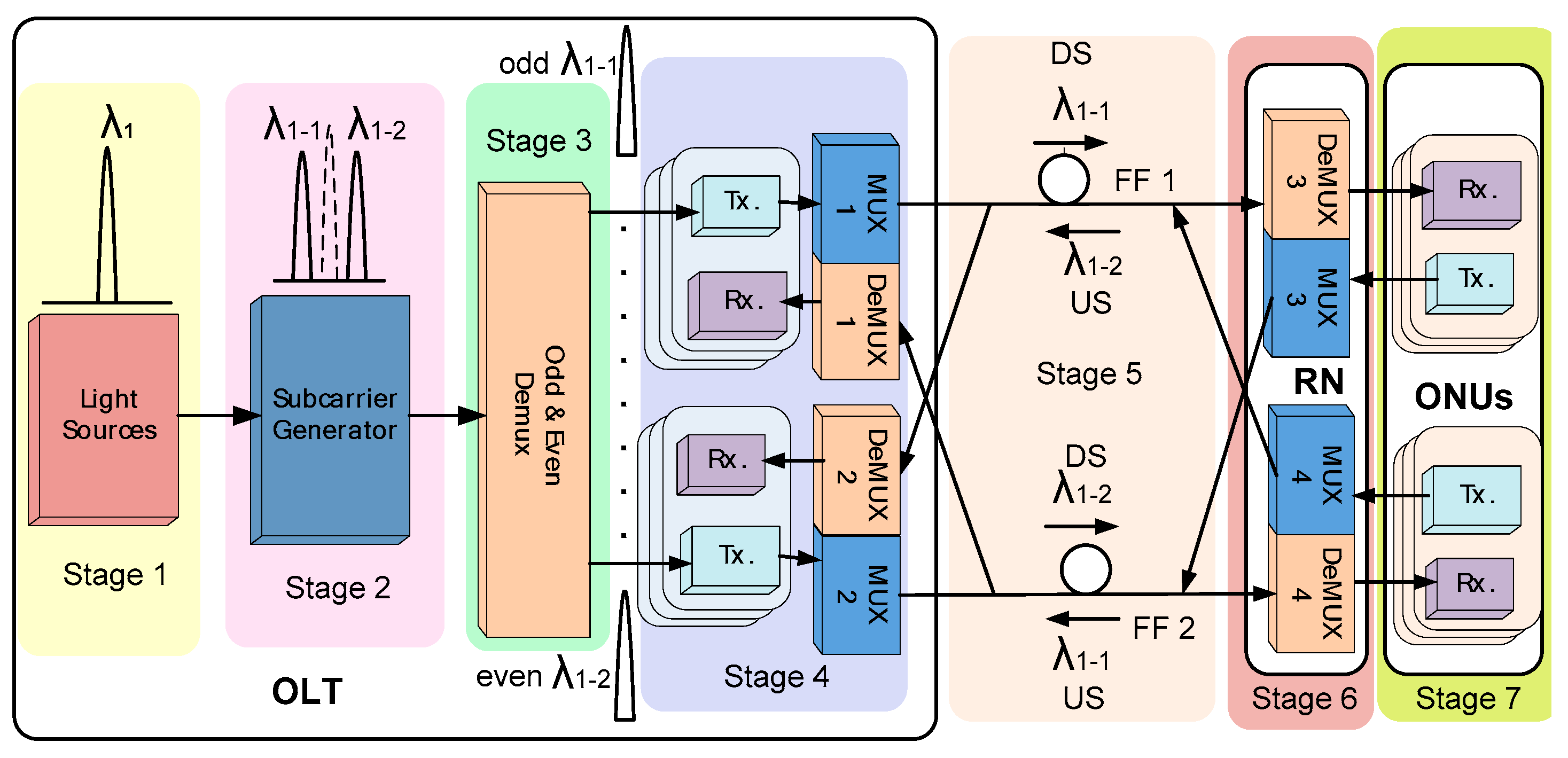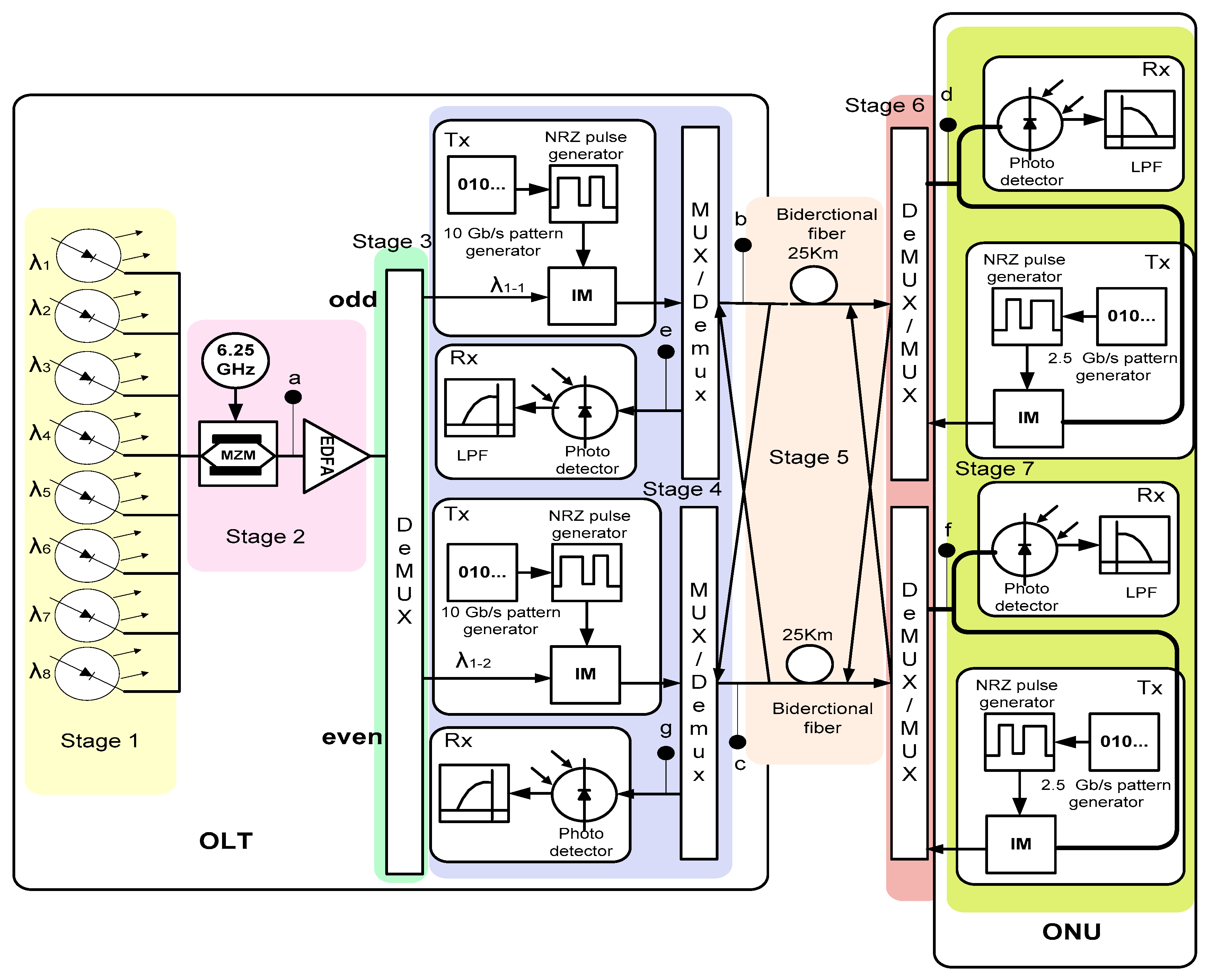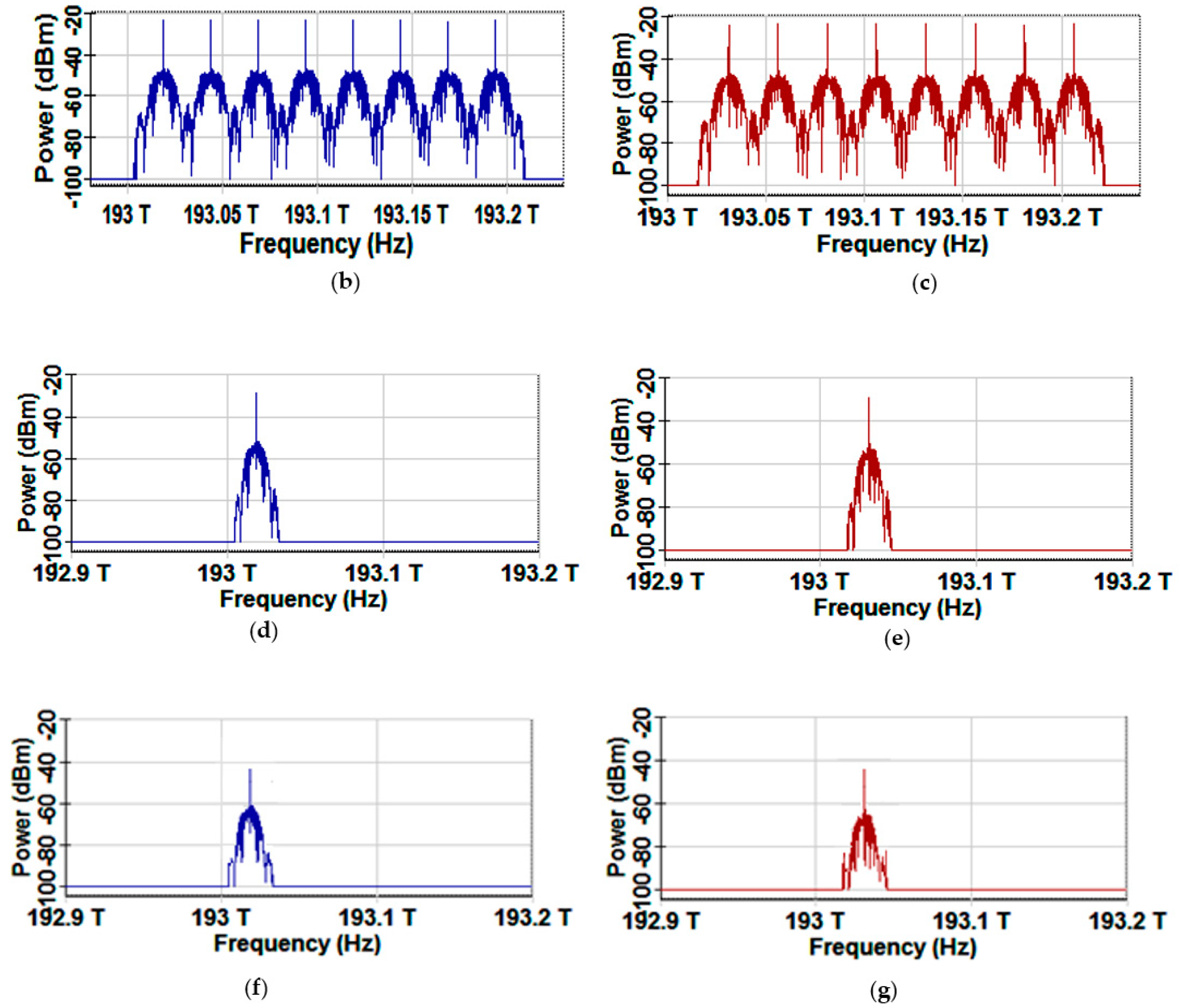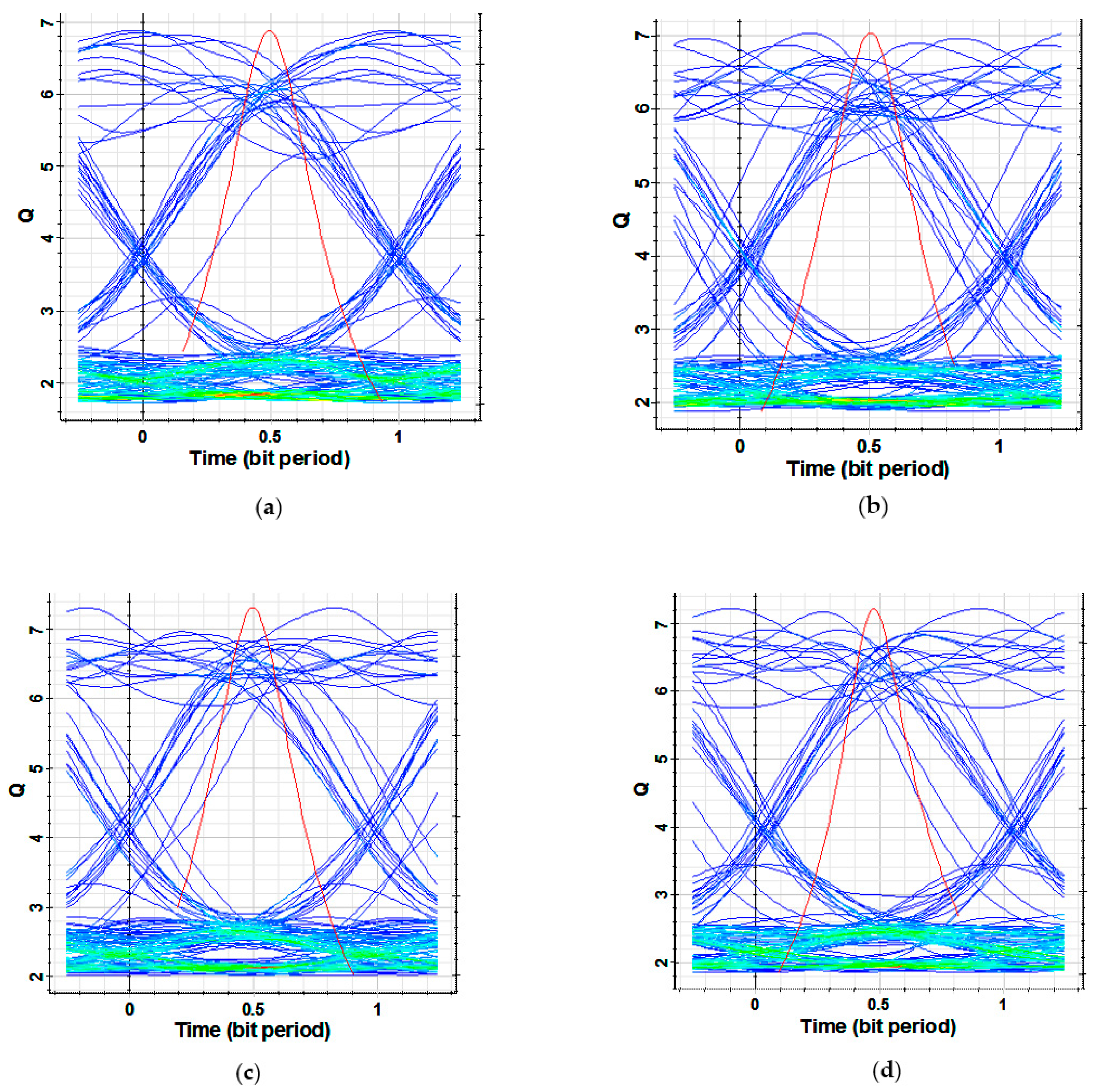Performance Enhancement and Capacity Enlargement for a DWDM-PON System Utilizing an Optimized Cross Seeding Rayleigh Backscattering Design
Abstract
1. Introduction
2. The System’s Design, Architecture, and Operating Principles
3. Extended System Architecture and Parameters
4. Results and Discussion
5. Comparison with Related Studies
6. Conclusions
Author Contributions
Funding
Conflicts of Interest
References
- Bindhaiq, S.; Supaat, A.S.M.; Zulkifli, N.; Mohammad, A.B.; Shaddad, R.Q.; Elmagzoub, M.A.; Faisal, A. Recent development on time and wavelength-division multiplexed passive optical network (TWDM-PON) for next-generation passive optical network stage 2 (NG-PON2). Opt. Switch. Netw. 2015, 15, 53–66. [Google Scholar] [CrossRef]
- Kaminow, I.; Li, T.Y.; Willner, A. Optical Fiber Telecommunications VIB Systems and Networks, 6th ed.; Elsevier: Waltham, MA, USA, 2013; pp. 928–929. [Google Scholar]
- Cheng, M.C.; Tsai, C.T.; Chi, Y.C.; Lin, G.R. Direct QAM-OFDM Encoding of an L-band Master-to-Slave Injection-Locked WRC-FPLD Pair for 28 × 20 Gb/s DWDM-PON Transmission. J. Lightwave Technol. 2014, 32, 2981–2988. [Google Scholar] [CrossRef]
- Chen, J.; Wosinska, L.; He, S. High Utilization of Wavelengths and Simple Interconnection Between Users in a Protection Scheme for Passive Optical Networks. IEEE Photonics Technol. Lett. 2008, 20, 389–391. [Google Scholar] [CrossRef]
- Xu, Z.; Wen, Y.J.; Zhong, W.D.; Chae, C.J.; Cheng, X.F.; Wang, Y.; Lu, C.; Shankar, J. High-speed WDM-PON using CW injection-locked Fabry-Pérot laser diodes. Opt. Express 2007, 15, 2953–2962. [Google Scholar] [CrossRef]
- Lin, S.Y.; Chi, Y.C.; Su, Y.C.; Liao, J.W.; Wang, H.L.; Lin, G.C.; Lin, G.R. Coherent Injection-Locking of Long-Cavity Colorless Laser Diodes with Low Front-Facet Reflectance for DWDM-PON Transmission. IEEE J. Sel. Top. Quantum Electron. 2013, 19, 1501011. [Google Scholar]
- Lin, S.C.; Lee, S.L.; Liu, C.K. Simple approach for bidirectional performance enhancement on WDM-PONs with direct-modulation lasers and RSOAs. Opt. Express 2008, 16, 3636–3643. [Google Scholar] [CrossRef]
- Naughton, A.; Talli, G.; Porto, S.; Antony, C.; Ossieur, P.; Townsend, P.D. Design Optimization of R-EAM-SOA for Long-Reach Carrier-Distributed Passive Optical Networks. J. Lightwave Technol. 2014, 32, 4386–4392. [Google Scholar] [CrossRef]
- Al-Qazwini, Z.; Kim, H. Symmetric 10-Gb/s WDM-PON Using Directly Modulated Lasers for Downlink and RSOAs for Uplink. J. Lightwave Technol. 2012, 30, 1891–1899. [Google Scholar] [CrossRef]
- Guo, Q.; Tran, A.V. 40 Gb/s Operation of SOA-REAM in Single-Feeder WDM-PON [Invited]. J. Opt. Commun. Netw. 2012, 4, 77–84. [Google Scholar] [CrossRef]
- Chow, C.W.; Yeh, C.H.; Wu, Y.F.; Lin, Y.H.; Shih, F.Y.; Chi, S. Rayleigh Backscattering Circumvention in Ring-Based Access Network Using RSOA-ONU. IEEE Photonics Technol. Lett. 2011, 23, 1121–1123. [Google Scholar] [CrossRef]
- Senior, J.M. Optical Fiber Communications Principles and Practice, 3rd ed.; Pearson Education: London, UK, 2009; pp. 95–97. [Google Scholar]
- Nakazawa, M. Rayleigh backscattering theory for single-mode optical fibers. J. Opt. Soc. Am. 1983, 73, 1175–1180. [Google Scholar] [CrossRef]
- Liaw, S.K.; Tzeng, S.L.; Hung, Y.J. Rayleigh backscattering induced power penalty on bidirectional wavelength-reuse fiber systems. Opt. Commun. 2001, 188, 63–67. [Google Scholar] [CrossRef]
- Staubli, R.K.; Gysel, P. Crosstalk penalities due to coherent Rayleigh noise in bidirectional optical communication systems. J. Lightwave Technol. 1991, 9, 375–380. [Google Scholar] [CrossRef]
- Xu, M.; Chi, Y.C.; Wang, J.; Cheng, L.; Lu, F.; Khalil, M.I.; Tsai, C.T.; Lin, G.R.; Chang, G.K. Wavelength sharing and reuse in dual-band WDM-PON systems employing WRC-FPLDs. IEEE Photonics Technol. Lett. 2015, 27, 1821–1824. [Google Scholar] [CrossRef]
- Simatupang, J.W.; Lee, S.L. Transfer matrix analysis of backscattering and reflection effects on WDM-PON systems. Opt. Express 2013, 21, 27565–27577. [Google Scholar] [CrossRef]
- Chow, C.W.; Yeh, C.H. Using Downstream DPSK and Upstream Wavelength-Shifted ask for Rayleigh Backscattering Mitigation in TDM-PON to WDM-PON Migration Scheme. IEEE Photonics J. 2013, 5, 7900407. [Google Scholar] [CrossRef]
- Chowdhury, A.; Chien, H.C.; Huang, M.F.; Yu, J.; Chang, G.K. Rayleigh Backscattering Noise-Eliminated 115-km Long-Reach Bidirectional Centralized WDM-PON with 10-Gb/s DPSK Downstream and Remodulated 2.5-Gb/s OCS-SCM Upstream Signal. IEEE Photonics Technol. Lett. 2008, 20, 2081–2083. [Google Scholar] [CrossRef]
- Omella, M.; Lazaro, J.; Polo, V.; Prat, J. Driving Requirements for Wavelength Shifting in Colorless ONU With Dual-Arm Modulator. J. Lightwave Technol. 2009, 27, 3912–3918. [Google Scholar] [CrossRef]
- De Valicourt, G.; Make, D.; Landreau, J.; Lamponi, M.; Duan, G.; Chanclou, P.; Brenot, R. High Gain (30 dB) and High Saturation Power (11 dBm) RSOA Devices as Colorless ONU Sources in Long-Reach Hybrid WDM/TDM-PON Architecture. IEEE Photonics Technol. Lett. 2010, 22, 191–193. [Google Scholar] [CrossRef]
- Zhou, Z.; Xiao, S.; Qi, T.; Li, P.; Bi, M.; Hu, W. 25-GHz-Spaced DWDM-PON with Mitigated Rayleigh Backscattering and Back-Reflection Effects. IEEE Photonics J. 2013, 5, 7901407. [Google Scholar] [CrossRef]
- Lin, S.C.; Lee, S.L.; Lin, H.H.; Keiser, G.; Ram, R.J. Cross-Seeding Schemes for WDM-Based Next-Generation Optical Access Networks. J. Lightwave Technol. 2011, 29, 3727–3736. [Google Scholar] [CrossRef]
- Huang, Q.; Peng, P.C.; Fu, S.F.; Yang, W.Y.; Huang, J.H.; Yee, H.H. Double Sideband with Optical Carrier Suppression Scheme for Broadcasting Transmission. IEEE Photonics Technol. Lett. 2014, 26, 1172–1175. [Google Scholar]
- Yeh, C.H.; Chow, C.W.; Chen, H.Y. Simple Colorless WDM-PON with Rayleigh Backscattering Noise Circumvention Employing m-QAM OFDM Downstream and Remodulated OOK Upstream Signals. J. Lightwave Technol. 2012, 30, 2151–2155. [Google Scholar] [CrossRef]
- Chiuchiarelli, A.; Proietti, R.; Presi, M.; Choudhury, P.; Contestabile, G.; Ciaramella, E. Symmetric 10 Gbit/s WDM-PON based on cross-wavelength reuse to avoid Rayleigh backscattering and maximise band usage. Electron. Lett. 2009, 45, 1343. [Google Scholar] [CrossRef]
- Agalliu, R.; Lucki, M. Benefits and Limits of Modulation Formats for Optical Communications. Adv. Electr. Electron. Eng. 2014, 12, 160–167. [Google Scholar] [CrossRef]
- Feng, Q.G.; Li, W.; Zheng, Q.; Han, J.L.; Xiao, J.X.; He, Z.X.; Luo, M.; Yang, Q.; Yu, S.H. Impacts of backscattering noises on upstream signals in full-duplex bidirectional PONs. Opt. Express 2015, 23, 15575–15586. [Google Scholar] [CrossRef]
- Xu, J.; Li, M.; Chen, L.K. Rayleigh Noise Reduction in 10-Gb/s Carrier-Distributed WDM-PONs Using In-Band Optical Filtering. J. Lightwave Technol. 2011, 29, 3632–3639. [Google Scholar]
- Lin, C.F. Optical Components for Communications: Principles and Applications, 1st ed.; Springer Science & Business Media: New York, NY, USA, 2004; pp. 277–292. [Google Scholar]
- Anritsu Corporation. Available online: https://rintintin.colorado.edu/~gifford/5830-AWL/Anritsu%20Eye%20Diagram.pdf (accessed on 15 July 2019).
- Breed, G. Analyzing signals using the eye diagram. High Freq. Electron. 2005, 4, 50–53. [Google Scholar]
- Senior, J.M. Optical Fiber Communications Principles and Practice, 3rd ed.; Pearson Education: London, UK, 2009; pp. 708–713. [Google Scholar]
- Simatupang, J.W.; Pukhrambam, P.D.; Huang, Y.R. Performance analysis of cross-seeding WDM-PON system using transfer matrix method. Opt. Fiber Technol. 2016, 32, 50–57. [Google Scholar] [CrossRef]
- Mohammed, N.A.; Solaiman, M.; Aly, M.H. Design and performance evaluation of a dispersion compensation unit using several chirping functions in a tanh apodized FBG and comparison with dispersion compensation fiber. Appl. Opt. 2014, 53, 239–247. [Google Scholar] [CrossRef]
- Mohammed, N.A.; Okasha, N.M. Single-and dual-band dispersion compensation unit using apodized chirped fiber Bragg grating. J. Comput. Electron. 2018, 17, 349–360. [Google Scholar] [CrossRef]
- Mohammed, N.A.; Elkhamisy, K.M.; Aly, M.H. Pedestal Free Pulse Source for Ultrahigh Data Rate Optical Time Division Multiplexing Systems Self-Phase Modulation Based. J. Nanoelectron. Optoelectron. 2017, 12, 505–511. [Google Scholar] [CrossRef][Green Version]
- Elewah, I.A.; Mohammed, N.A.; Aly, M.H. 20-Gb/s Transmission Over 25-km in Wavelength Division Multiplexing Passive Optical Network with Centralized Light Source. J. Nanoelectron. Optoelectron. 2017, 12, 242–246. [Google Scholar] [CrossRef]
- Mohammed, N.A.; Badawi, K.A. Design and Performance Evaluation for a Non-Line of Sight VLC Dimmable System Based on SC-LPPM. IEEE Access 2018, 6, 52393–52405. [Google Scholar] [CrossRef]
- Mohammed, N.A.; Elkarim, M.A. Exploring the effect of diffuse reflection on indoor localization systems based on RSSI-VLC. Opt. Express 2015, 23, 20297–20313. [Google Scholar] [CrossRef]
- Mostafa, T.S.; Mohammed, N.A.; El-Rabaie, E.S.M. Ultracompact ultrafast-switching-speed all-optical 4 × 2 encoder based on photonic crystal. J. Comput. Electron. 2019, 18, 279–292. [Google Scholar] [CrossRef]
- Mostafa, T.S.; Mohammed, N.A.; El-Rabaie, E.S.M. Ultra-High bit rate all-optical AND/OR logic gates based on photonic crystal with multi-wavelength simultaneous operation. J. Mod. Opt. 2019, 66, 1005–1016. [Google Scholar] [CrossRef]
- Mohammed, N.A.; Hamed, M.M.; Khalaf, A.A.; Alsayyari, A.; EL-Rabaie, S. High-sensitivity ultra-quality factor and remarkable compact blood components biomedical sensor based on nanocavity coupled photonic crystal. Results Phys. 2019, 14, 102478. [Google Scholar] [CrossRef]





| Component | Parameter | Value(s) | Unit |
|---|---|---|---|
| CW Laser | First Wavelength | 193.025 | THz |
| Wavelength spacing | 25 | GHz | |
| Launching power | 0 | dB | |
| Sine Generator | Frequency | 6.25 | GHz |
| OLT Transmitter | DS Bit rate | 10 | Gb/s |
| Bidirectional optical fiber | Length | 25 | Km |
| Attenuation | 0.2 | dB/Km | |
| ONU Transmitter | US Bit rate | 2.5 | Gb/s |
| Ref | System | No. of Channels | Maximum 1 Length Km | Minimum 2 Channel Spacing GHz | Maximum 1 US Bit Rate Gb/s | Maximum 1 DS Bit Rate Gb/s | Optimum BER |
|---|---|---|---|---|---|---|---|
| [5] | WDM-PON | 16 | 15 | 140 | 10 | 10 | 10−9 |
| [6] | DWDM-PON | 3 | 25 | 200 | 2.5 | 2.5 | 10−9 |
| [7] | DRWDM-PON 3 | 2 | 25 | 100 | 1.25 | 10 | 10−9 |
| [8] | Class C GPON 4 | 1 | NA | 10 | 10 | 10−10 | |
| [9] | WDM-PON | 4 | 20 | NA | 10 | 10 | 10−4 |
| [10] | WDM-PON | 1 | 20 | 40 | 40 | 10−4 | |
| [11] | WDM-TDM | 2 | 20 | 50 | 2.5 | 10 | 10−9 |
| [18] | Migration scheme from TDM-PON to WDM-PON | 1 | 20 | 10 | 10 | <10−9 for DS 10−3 for US | |
| [19] | Long-Reach Bidirectional Centralized WDM-PON | 1 | 115 | 2.5 | 10 | 10−10 | |
| [20] | WDM-PON With Wavelength Shifting in Colorless ONU | 1 | 25 | 1.25 | 2.50 | 10−9 | |
| [21] | Hybrid WDM/TDM-PON | 8 | 45 | 100 | 2.5 | 2.5 | 10−7 |
| [22] | DWDM-PON | 6 | 25 | 25 | 1.25 | 10 | 10−9 |
| [23] | WDM-PON | 2 | 25 | 100 | 1.25 | 10 | 10−10 |
| [34] | WDM-PON | NA | 25 | NA | NA | NA | 10−9 |
| This work | DWDM-PON | 16 | 25 | 12.5 | 2.5 | 10 | 10−12 |
© 2019 by the authors. Licensee MDPI, Basel, Switzerland. This article is an open access article distributed under the terms and conditions of the Creative Commons Attribution (CC BY) license (http://creativecommons.org/licenses/by/4.0/).
Share and Cite
A. Mohammed, N.; Hamdi Mansi, A. Performance Enhancement and Capacity Enlargement for a DWDM-PON System Utilizing an Optimized Cross Seeding Rayleigh Backscattering Design. Appl. Sci. 2019, 9, 4520. https://doi.org/10.3390/app9214520
A. Mohammed N, Hamdi Mansi A. Performance Enhancement and Capacity Enlargement for a DWDM-PON System Utilizing an Optimized Cross Seeding Rayleigh Backscattering Design. Applied Sciences. 2019; 9(21):4520. https://doi.org/10.3390/app9214520
Chicago/Turabian StyleA. Mohammed, Nazmi, and Ahmed Hamdi Mansi. 2019. "Performance Enhancement and Capacity Enlargement for a DWDM-PON System Utilizing an Optimized Cross Seeding Rayleigh Backscattering Design" Applied Sciences 9, no. 21: 4520. https://doi.org/10.3390/app9214520
APA StyleA. Mohammed, N., & Hamdi Mansi, A. (2019). Performance Enhancement and Capacity Enlargement for a DWDM-PON System Utilizing an Optimized Cross Seeding Rayleigh Backscattering Design. Applied Sciences, 9(21), 4520. https://doi.org/10.3390/app9214520





